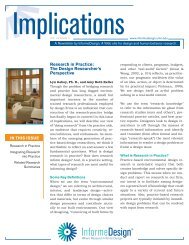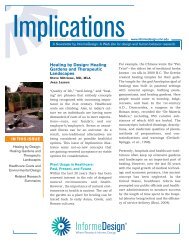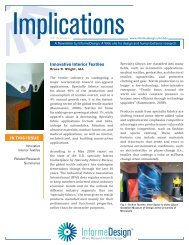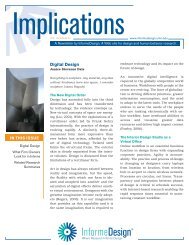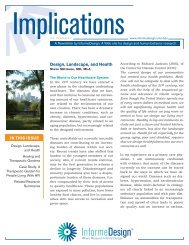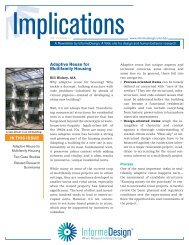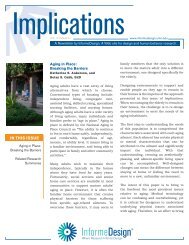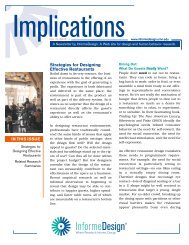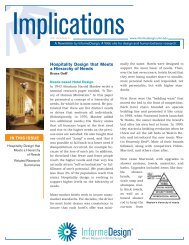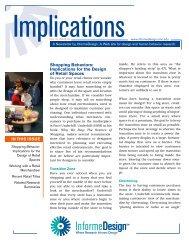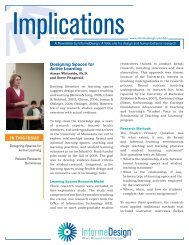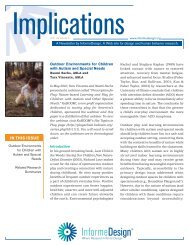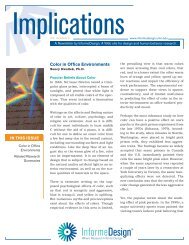Community-Based Child Care Settings: Vol. 6, Issue 1 - InformeDesign
Community-Based Child Care Settings: Vol. 6, Issue 1 - InformeDesign
Community-Based Child Care Settings: Vol. 6, Issue 1 - InformeDesign
You also want an ePaper? Increase the reach of your titles
YUMPU automatically turns print PDFs into web optimized ePapers that Google loves.
Implications<br />
www.informedesign.umn.edu<br />
<br />
home, because of the amount of time young children<br />
spend in child care, these places must fulfill some<br />
of the home’s functions, including providing a sense<br />
of place. The physical environment’s design therefore<br />
seeks to meet both the growing child’s developmental<br />
needs and provide a sense of place.<br />
What are the specific design issues for a communitybased<br />
child care program? How are these issues<br />
related to the child’s developmental and emotional/<br />
psychological needs? How do these design issues relate<br />
to a sense of place? Scale, complexity, adjacencies<br />
and zones, size of space, legibility, and adult spaces<br />
all must be addressed in the design (or redesign) of a<br />
child care space.<br />
Scale<br />
The environment’s scale must be appropriate to the<br />
children’s age and ability. Scale refers to all aspects of<br />
the child care space including furniture, displays and<br />
decorations intended for children, windows, doors,<br />
and fixtures such as sink faucets and door handles.<br />
If the physical environment is appropriately scaled,<br />
children will be able to gain a sense of mastery over<br />
the environment (Trancik & Evans, 1995).<br />
Place play items within children’s reach, enabling<br />
them to retrieve and store items on their own. Make<br />
displays intended for children easily visible to them.<br />
For example, in an infants’ space, place pictures,<br />
mirrors, and items for tactile exploration on the floor<br />
or low on the wall. Put sink faucets and door handles<br />
within the preschool child’s reach so children can<br />
easily manipulate them. Jim Greenman (1998)<br />
suggests levers for doors and faucets because they<br />
can be more easily operated by children than handles<br />
or knobs. Windows at children’s height allow them<br />
to view the outdoors. Risers placed on the floor for<br />
infants to climb on contribute to motor development<br />
and a sense of mastery. Give older children easy access<br />
to their own cubbie and space to practice dressing<br />
and undressing. In addition, since everything in the<br />
family home is not child-scaled, the child care space<br />
should contain some scale variation so that children<br />
can master increasing skill levels.<br />
Complexity<br />
The family home usually contains a fairly high level of<br />
complexity. There is a range of items for children and<br />
adults. The home has a variety of colors, textures,<br />
scale, and scents. There are many things for children<br />
to view and manipulate. Complexity can encourage<br />
children to explore, but too much complexity can be<br />
overwhelming and may inhibit exploration. Provide a<br />
variety of toys and activities, opportunities for tactile<br />
exploration, lighting to support different activities,<br />
small changes in scale (e.g., climbing equipment or<br />
an adult-sized sofa where children and adults can sit<br />
together), and some variation in colors. Variety must<br />
be kept in moderation, however.<br />
Color variety can<br />
come from toys<br />
and the children’s<br />
artwork, but too<br />
many colors on the<br />
walls or floors can<br />
be distracting. Use<br />
color to designate<br />
areas for specific<br />
activities such as art<br />
or reading. Provide tactile experiences with water<br />
tables, plants, and a variety of furniture coverings.<br />
Provide lighting from both natural and artificial<br />
sources and both must be controllable to suit specific<br />
activities and needs. The appropriate amount of<br />
physical complexity can help ensure children are not<br />
bored but have opportunities to engage in activities<br />
that will enhance their enjoyment and development.<br />
Adjacencies/Zones<br />
Adjacencies refer to the relationship of various spaces<br />
to each other. Zones refer to the hierarchy of spaces<br />
or, stated another way, the relationship of public and<br />
private spaces to each other. In the home, there is<br />
usually a strong physical distinction between public<br />
and private spaces. Sleeping and personal hygiene<br />
areas are away from more public spaces such as the<br />
living/dining areas. At home, children learn that<br />
certain activities take place in private zones and other<br />
activities are for more public areas.<br />
Where Research Informs Design®



